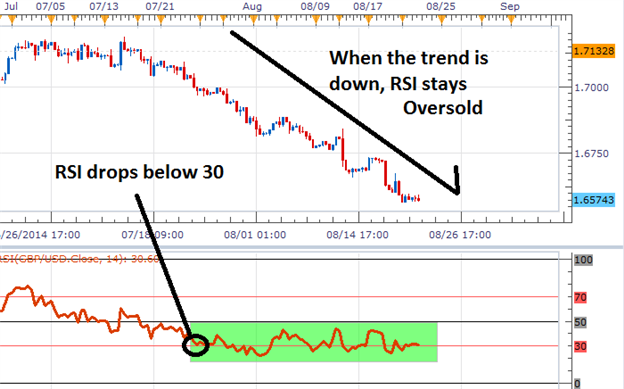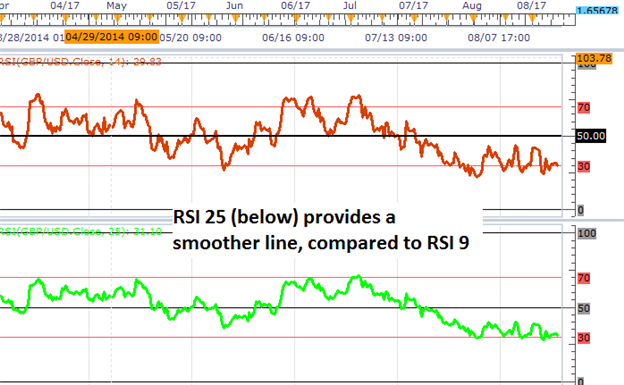3 Trading Tips for Relative Strength Index trading
by
, 09-28-2014 at 09:32 PM (2230 Views)
Talking Points
- In a Downtrend, RSI Can Remain Oversold
- Use the Centerline to Determine Market Direction
- Settings Can be Adjusted for More or Less Oscillation
RSI (Relative Strength Index) is counted among trading’s most popular indicators. This is for good reason, because as a member of the oscillator family, RSI can help us determine the trend, time entries, and more. Today to help become better acquainted with the indicator, we will review three uncommon tips for trading with RSI.
GBPUSD 8 Hour
Think Beyond the Crossovers
When traders first learn about RSI and other oscillators, they tend to gravitate to overbought and oversold values. While these are intuitive points to enter in the market on retracements, this can be counterproductive in strong trending environments. RSI is considered a momentum oscillator, and this means extended trends can keep RSI overbought or oversold for long periods of time.
Above we can see a prime example using RSI on a GBPUSD 8Hour chart. Even though RSI dropped below a reading of 30, on July 27th, price continued to decline as much as 402 pips through today’s trading. This could have spelled trouble for traders looking to buy on a RSI crossover from overbought values. Instead consider the alternative and look to sell the market when RSI is oversold in a downtrend, and buying when RSI is overbought in an uptrend.
GBPUSD 8 Hour
Watch the Center Line
All oscillators have a center line and more often than not, they become a forgotten backdrop compared to the indicator itself. RSI is no different with a center line found in the middle of the range at a reading of 50. Technical traders use the centerline to show shifts in the trend. If RSI is above 50, momentum is considered up and traders can look for opportunities to buy the market. A drop below 50 would indicate the development of a new bearish market trend.
In the graph above we can again see our GBPUSD example using an 8HR chart. Notice how when price pushed upward, RSI remained above 50. Even at times, the center line acted as indicator support as RSI failed to break below this value on June 24 th prior to the creation of a higher high. However, as momentum shifted, RSI dropped below 50 indicating a bearish reversal. Knowing this, traders could conclude any existing long positions, or look for order entries with prices new direction.
Check Your Parameters
RSI like many other oscillators is defaulted to a 14 period setting. This means the indicator looks back 14 bars on whatever graph you may be viewing, to create its reading. Even though 14 is the defaulted setting that may not make it the best setting for your trading. Normally short term traders use a smaller period, such as a 7 period RSI, to create more indicator oscillator. While longer term traders may opt for a higher period, such as a 25 period RSI) for a mother indicator line.
In our final comparison, you can see a 9 period RSI line side by side with a 25 period RSI line. While there may not seem like much difference at first glance, pay close attention to the centerline along with crossovers of the 70 and 30 values. The RSI 9 at the top of the graph has considerably more oscillation compared to its RSI 25 counterpart.
---Written by Walker England, Trading Instructor
More...















 Email Blog Entry
Email Blog Entry